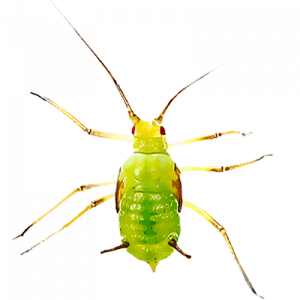
aphid, (family Aphididae), also called plant louse, greenfly, or ant cow, any of a group of sap-sucking, soft-bodied insects (order Homoptera) that are about the size of a pinhead, most species of which have a pair of tubelike projections (cornicles) on the abdomen. Aphids can be serious plant pests and may stunt plant growth, produce plant galls, transmit plant virus diseases, and cause the deformation of leaves, buds, and flowers.
The life cycle of the aphid is complicated. Wingless females, called stem mothers, reproduce without fertilization (i.e., by parthenogenesis) throughout the summer. These stem mothers are unique in that they produce living young (viviparity) as opposed to eggs, as occurs in most other insects.
Eventually the plant containing the stem mother and her offspring becomes overcrowded. When this occurs, some offspring develop into adults with two pairs of large membranous wings. These winged adults fly to new plants. In late summer both males and females are produced.
After they mate, the female lays eggs that survive the winter. In warm climates there may be no need for an overwintering egg stage, and continuous generations occur. The white woolly-ball appearance of many aphids is the result of wax-gland secretion. Aphids are often controlled by natural enemies such as ladybird beetles, aphidlions, and lacewings.
However, when economically or aesthetically damaging numbers are present, they can be controlled by insecticidal soaps, horticultural oils, and other traditional insecticides.
Ants may guard and care for aphids in return for the honeydew (a sweet excretory product) they produce. Ants protect aphids from weather and natural enemies and transfer them from wilted to healthy plants. In this way the ants ensure their source of honeydew, which they use as food. Ants obtain honeydew by stroking, or “milking,” the aphids. Common types of aphids include the following:
More than 4,000 species of aphids have been described, some 250 of which are pests of crops and ornamental plants. The life history, ecology, and agricultural significance of select species are described in the following paragraphs.
The apple aphid (Aphis pomi) is yellow-green with dark head and legs. It overwinters as a black egg on its only host, the apple tree. It produces honeydew that supports growth of a sooty mold.
The cabbage aphid (Brevicoryne brassicae) is small and gray-green with a powdery, waxy covering. It is found in clusters on the underside of leaves of cabbage, cauliflower, Brussels sprouts, and radishes. It overwinters as black eggs in northern regions but has no sexual stage in southern regions. When necessary, it can be controlled with the use of insecticides.

aphids-pest-control-nairobi-kenya